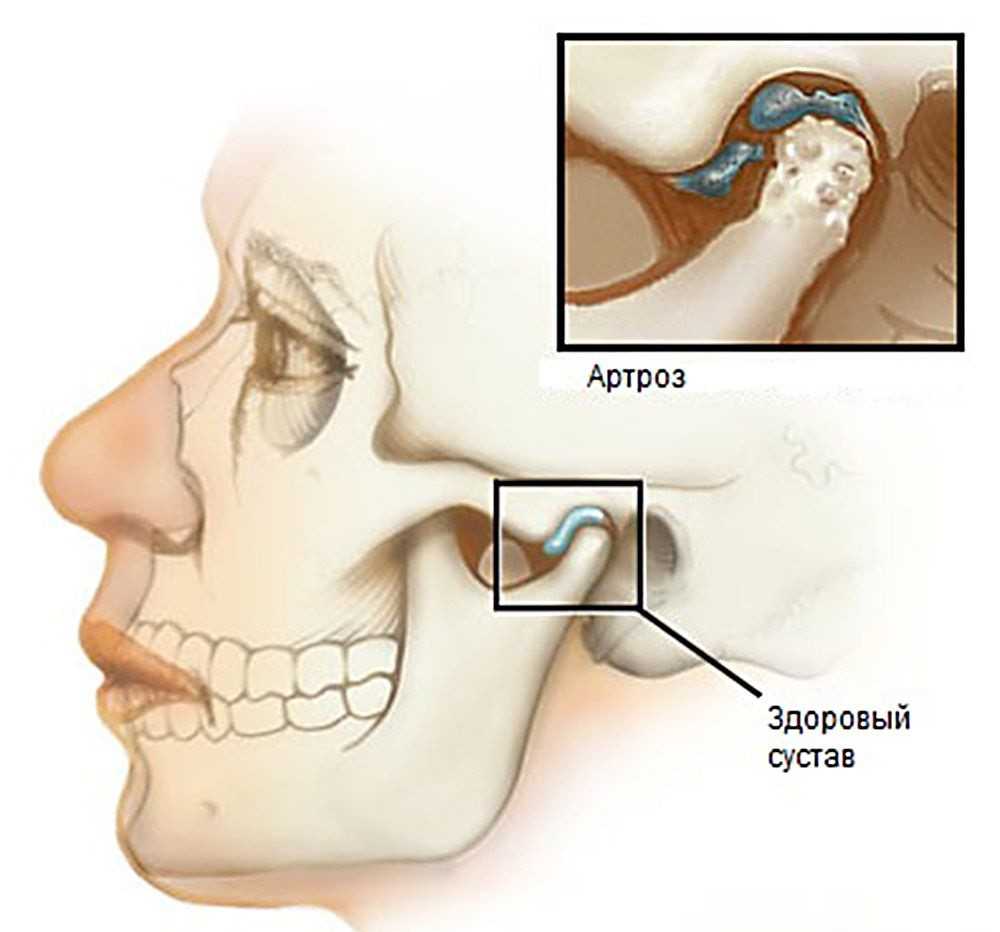What is temporomandibular. Temporomandibular Disorders (TMD): Symptoms, Causes, and Diagnosis
What are the common symptoms of TMD. How is TMD diagnosed. What factors can contribute to the development of temporomandibular disorders. Can TMD be related to other health conditions. What treatment options are available for managing TMD symptoms.
Understanding Temporomandibular Disorders (TMD)
Temporomandibular disorders (TMD) are a group of conditions affecting the jaw muscles, temporomandibular joints (TMJ), and associated nerves. These disorders can lead to chronic facial pain and discomfort, impacting daily activities such as chewing, talking, and yawning. The complex nature of the temporomandibular joint, which connects the lower jaw to the skull, makes it susceptible to various problems when its components are not working in harmony.
Types of TMD
The National Institute of Dental and Craniofacial Research (NIDCR) classifies TMD into three main categories:
- Myofascial pain: This is the most common form, affecting the fascia and muscles controlling jaw, neck, and shoulder function.
- Internal derangement of the joint: This involves dislocation of the jaw or displacement of the disk that cushions the joint.
- Degenerative joint disease: This includes conditions like osteoarthritis or rheumatoid arthritis in the jaw joint.
It’s important to note that an individual may experience one or more of these conditions simultaneously, contributing to the complexity of TMD diagnosis and treatment.
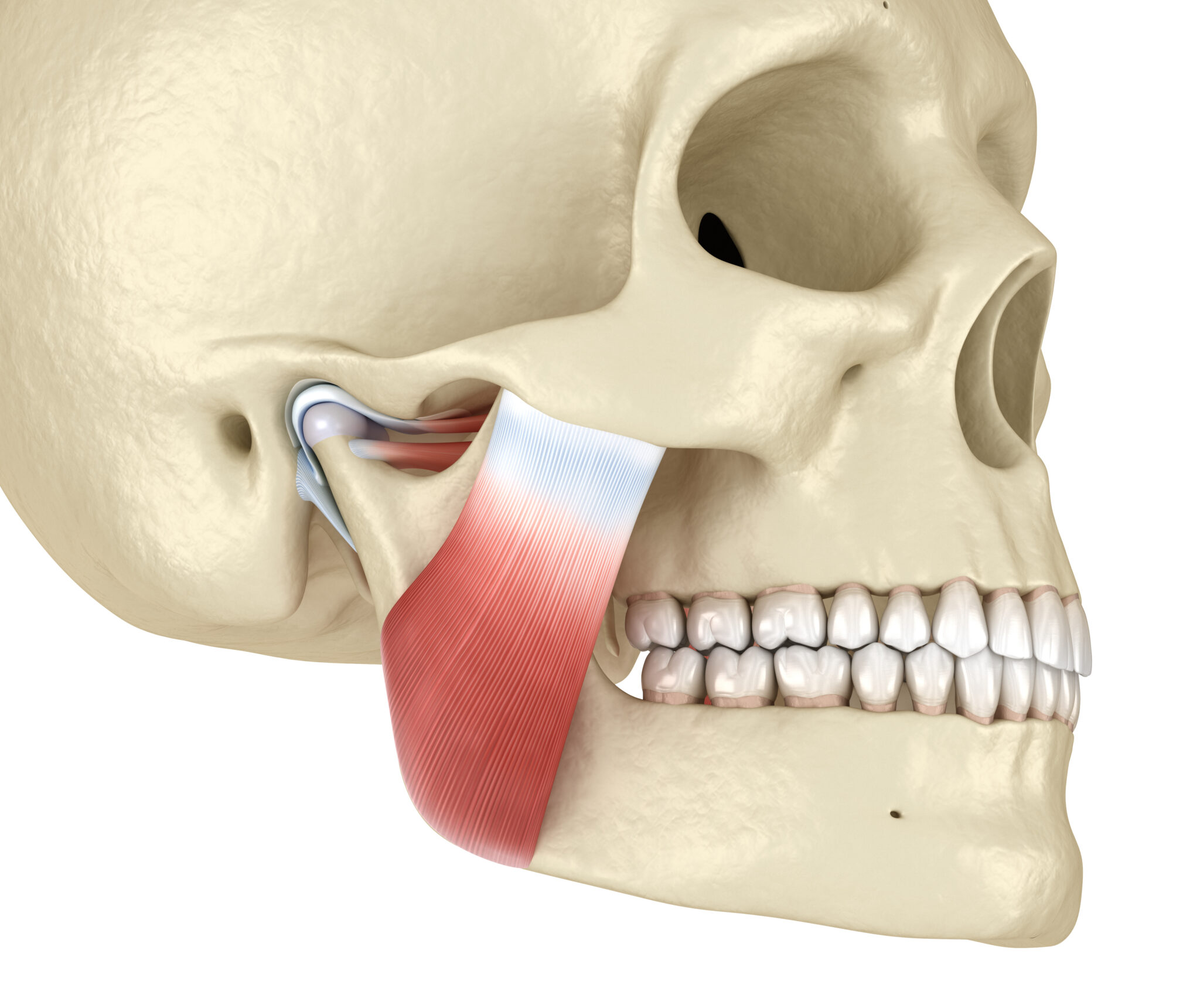
Causes and Risk Factors of TMD
The exact cause of TMD is not always clear, but several factors can contribute to its development:
- Excessive strain on jaw joints and muscles
- Bruxism (teeth grinding or clenching)
- Jaw, head, or neck injuries
- Arthritis
- Displacement of jaw joint disks
Recent research by the NIDCR has identified additional factors that may increase the risk of developing chronic TMD, including clinical, psychological, sensory, genetic, and nervous system factors.
Can other health conditions influence TMD?
Yes, certain health conditions can overlap with or exacerbate TMD symptoms. Conditions such as fibromyalgia and irritable bowel syndrome have been associated with an increased prevalence of TMD. This connection highlights the importance of a comprehensive approach to diagnosis and treatment, considering the potential interplay between various health issues.
Recognizing TMD Symptoms
TMD can manifest through a variety of symptoms, which may vary in intensity and duration among individuals. Common symptoms include:

- Jaw discomfort or soreness, often more pronounced in the morning or late afternoon
- Headaches
- Facial, shoulder, neck, or back pain
- Earaches or tinnitus (ringing in the ears) not caused by ear infections
- Clicking or popping sounds in the jaw
- Jaw locking or limited mouth movements
- Teeth grinding or clenching
- Dizziness
- Unexplained teeth sensitivity
- Numbness or tingling in the fingers
- Changes in bite alignment
It’s crucial to note that these symptoms can mimic other health conditions, making accurate diagnosis essential for proper treatment.
Diagnostic Approaches for TMD
Diagnosing TMD often involves a multifaceted approach, combining various methods to ensure accuracy:
- Health history assessment: Your healthcare provider will inquire about past experiences of facial or jaw pain and other relevant medical information.
- Physical examination: This includes checking jaw movement, noting any sounds during jaw motion, and examining facial muscle tenderness.
- Dental examination: A dentist will assess your bite and look for signs of teeth grinding or other dental issues that may contribute to TMD.
- Imaging tests: X-rays, CT scans, or MRI may be used to visualize the jaw joint and surrounding structures.
Why is a comprehensive diagnosis important for TMD?
A thorough diagnostic process is crucial for TMD because its symptoms can overlap with other conditions. By utilizing multiple diagnostic tools, healthcare providers can rule out other potential causes and develop a targeted treatment plan. This comprehensive approach increases the likelihood of successful symptom management and improved quality of life for individuals with TMD.

Treatment Options for TMD
The treatment of TMD typically follows a conservative, multidisciplinary approach. Options may include:
- Self-care practices: Applying ice or heat packs, eating soft foods, and avoiding extreme jaw movements
- Physical therapy: Exercises to strengthen jaw muscles and improve flexibility
- Medications: Over-the-counter pain relievers, anti-inflammatories, or prescription medications as needed
- Oral appliances: Custom-fitted mouth guards or splints to prevent teeth grinding and reduce jaw tension
- Stress management techniques: Relaxation exercises, biofeedback, or counseling to address underlying stress factors
- Alternative therapies: Acupuncture or massage therapy may provide relief for some individuals
In rare cases where conservative treatments are ineffective, more invasive options such as corticosteroid injections or surgery may be considered. However, these are typically reserved for severe cases that do not respond to other interventions.
Living with TMD: Lifestyle Modifications and Self-Care
Managing TMD often requires a combination of professional treatment and self-care strategies. Incorporating the following lifestyle modifications can help alleviate symptoms and prevent flare-ups:

- Practice good posture to reduce strain on the jaw and neck muscles
- Avoid chewing gum or eating hard, chewy foods that require excessive jaw movement
- Use relaxation techniques to manage stress and reduce jaw clenching
- Apply moist heat or cold packs to the affected area for pain relief
- Perform gentle jaw stretching exercises as recommended by a healthcare provider
- Be mindful of jaw positioning throughout the day, maintaining a relaxed jaw stance
How can individuals effectively manage TMD symptoms at home?
Effective home management of TMD symptoms involves a combination of self-awareness and proactive measures. Regularly practicing relaxation techniques, maintaining proper posture, and being mindful of jaw habits can significantly reduce symptom frequency and intensity. Additionally, following a soft food diet during flare-ups and using over-the-counter pain relievers as directed by a healthcare provider can provide relief. It’s important to work closely with your healthcare team to develop a personalized self-care plan that addresses your specific TMD symptoms and triggers.

The Impact of TMD on Quality of Life
Temporomandibular disorders can significantly affect an individual’s daily life and overall well-being. The chronic pain and discomfort associated with TMD can lead to:
- Difficulty eating and speaking
- Sleep disturbances
- Reduced social interaction due to pain or embarrassment from jaw sounds
- Decreased work productivity
- Emotional distress, including anxiety and depression
Understanding the potential impact of TMD on quality of life underscores the importance of early diagnosis and comprehensive treatment. By addressing both the physical and emotional aspects of TMD, healthcare providers can help patients regain control over their symptoms and improve their overall well-being.
Can TMD affect mental health?
Yes, TMD can have a significant impact on mental health. The chronic pain and functional limitations associated with TMD can lead to feelings of frustration, anxiety, and depression. Additionally, the stress of dealing with a chronic condition can exacerbate TMD symptoms, creating a cycle of physical and emotional distress. Recognizing the connection between TMD and mental health is crucial for developing comprehensive treatment plans that address both the physical and psychological aspects of the disorder.

Advances in TMD Research and Treatment
The field of TMD research is continuously evolving, with new insights and treatment approaches emerging. Recent advancements include:
- Improved imaging techniques for more accurate diagnosis
- Development of biomarkers to identify individuals at risk for chronic TMD
- Exploration of gene therapies to target underlying causes of TMD
- Investigation of novel pain management strategies, including targeted nerve stimulation
- Integration of artificial intelligence in diagnosis and treatment planning
These ongoing research efforts aim to enhance our understanding of TMD and develop more effective, personalized treatment options for individuals suffering from this complex disorder.
How might future treatments for TMD differ from current approaches?
Future TMD treatments are likely to be more personalized and targeted, based on advancements in genetic research and biomarker identification. We may see the development of precision medicine approaches that tailor treatments to an individual’s specific genetic profile and risk factors. Additionally, non-invasive technologies such as advanced biofeedback systems and virtual reality-based therapies could play a larger role in TMD management. As our understanding of the complex interplay between physical, neurological, and psychological factors in TMD grows, treatment approaches will likely become more holistic, addressing multiple aspects of the disorder simultaneously for improved outcomes.
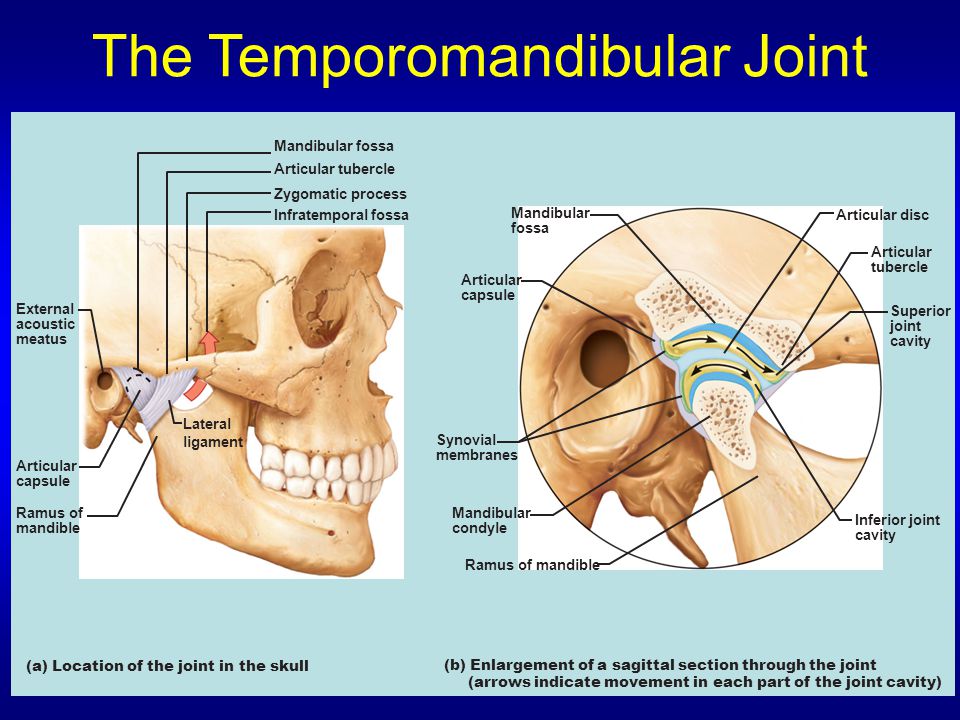
In conclusion, temporomandibular disorders represent a complex group of conditions that can significantly impact an individual’s quality of life. While diagnosis and treatment can be challenging due to the multifaceted nature of TMD, ongoing research and advancements in medical understanding continue to improve the outlook for those affected. By combining professional medical care with proactive self-management strategies, individuals with TMD can work towards reducing symptoms and improving their overall well-being. As research progresses, we can expect to see more targeted and effective treatments emerge, offering hope for better management and potentially even prevention of TMD in the future.
Temporomandibular Disorders (TMD) | Cedars-Sinai
ABOUT
CAUSES
DIAGNOSIS
TREATMENT
NEXT STEPS
What are temporomandibular disorders (TMD)?
Temporomandibular disorders (TMD) are disorders of the jaw
muscles, temporomandibular joints, and the nerves linked to chronic facial pain. Any
problem that prevents the complex system of muscles, bones, and joints from working
together in harmony may result in temporomandibular disorder.
The temporomandibular joints (TMJ) are the 2 joints that connect
your lower jaw to your skull. More specifically, they are the joints that slide and
rotate in front of each ear. They include the lower jaw (mandible) and the temporal
bone (the side and base of the skull). The TMJs are among the most complex joints
in
the body. These joints, along with several muscles, allow the mandible to move up
These joints, along with several muscles, allow the mandible to move up
and down, side to side, and forward and back. When the mandible and the joints are
correctly aligned, smooth muscle actions can take place. These include chewing,
talking, yawning, and swallowing. When these structures (muscles, ligaments, disk,
jaw bone, temporal bone) are not aligned they don’t move well together. This may
cause several problems to occur.
The National Institute of Dental and Craniofacial Research (NIDCR)
classifies TMD by the following:
- Myofascial pain. This is the
most common form of TMD. It results in discomfort or pain in the connective
tissue covering the muscles (fascia) and the muscles that control jaw, neck, and
shoulder function. - Internal derangement of the
joint.
This means a dislocated jaw or displaced disk. A disk is the
cushion of cartilage between the head of the jaw bone and the skull. Or it may
mean an injury to the condyle. This is the rounded end of the jaw bone that
articulates with the temporal skull bone. - Degenerative joint disease. This
includes osteoarthritis or rheumatoid arthritis in the jaw joint.
You can have 1 or more of these conditions at the same time.
What causes TMD?
In many cases, the actual cause of this disorder may not be clear.
Sometimes the main cause is too much strain on the jaw joints and the muscle group
that controls chewing, swallowing, and speech. This strain may be due to bruxism.
This is the habitual, involuntary clenching or grinding of the teeth.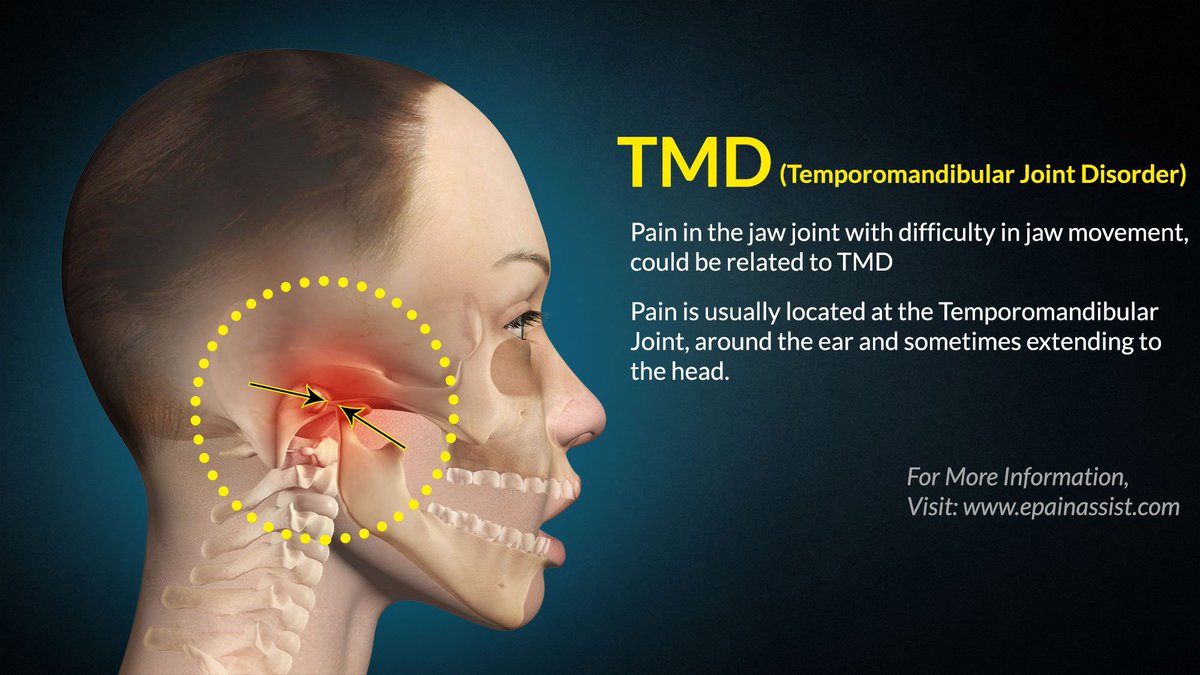 Injury to the
Injury to the
jaw, the head, or the neck may also cause TMD. Arthritis and displacement of the jaw
joint disks can also cause TMD pain. In other cases, another painful health
condition such as fibromyalgia or irritable bowel syndrome may overlap with or
worsen TMD pain. A recent study by the NIDCR identified clinical, psychological,
sensory, genetic, and nervous system factors that may put a person at higher risk
of
developing chronic TMD.
What are the symptoms of TMD?
The following are the most common symptoms of TMD:
- Jaw discomfort or soreness (often most common in the morning
or late afternoon) - Headaches
- Pain spreading behind the eyes, in the face, shoulder, neck,
or back - Earaches or ringing in the ears (not caused by an infection
of the inner ear canal) - Clicking or popping of the jaw
- Locking of the jaw
- Limited mouth motions
- Clenching or grinding of the teeth
- Dizziness
- Teeth sensitivity without an oral health disease
- Numbness or tingling feeling in the fingers
- A change in the way the upper and lower teeth fit
together
The symptoms of TMD may look like other conditions or health
problems.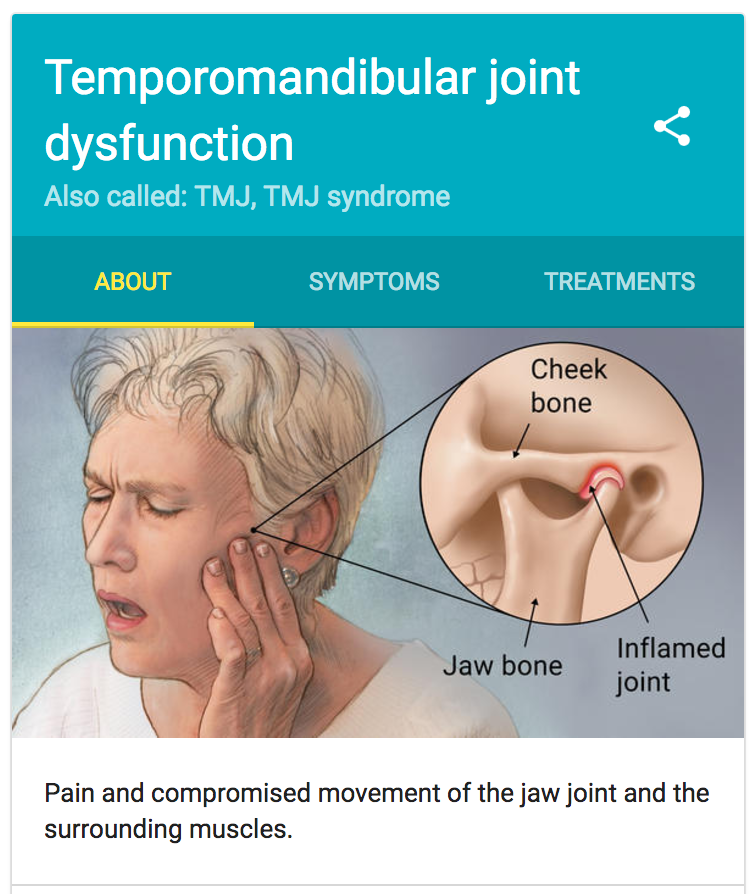 See a dentist or your healthcare provider for a diagnosis.
See a dentist or your healthcare provider for a diagnosis.
How is TMD diagnosed?
A variety of methods are used to diagnose TMD. These include:
- Health history. Your
healthcare provider will ask if you have a past history of facial or jaw
pain when you chew, bite, or open your mouth. Your provider will ask if you
have had cracking, popping, or noise when opening or closing your
mouth. - Physical exam. Your provider
will check if you have facial or jaw pain when moving your jaw, or can’t
open your mouth wide. They will also check for TMJ noises when you open or
close your mouth. - Imaging tests. X-rays, CT
scans, and MRIs may be used to clarify a diagnosis.
How is TMD treated?
Treatment will depend on your symptoms, age, and general health.
It will also depend on how severe the condition is.
Treatment may include:
- Resting the temporomandibular joint (TMJ)
- Medicine or pain relievers
- Relaxation methods and stress management
- Behavior changes (to reduce or stop teeth clenching)
- Physical therapy
- An orthopedic appliance or mouthguard worn in the mouth (to
reduce teeth grinding) - Posture training
- Diet changes such as eating soft foods (to rest the jaw
muscles) - Ice and hot packs
- Surgery
TMD symptoms can come back during times of stress. It is helpful
to be aware of what triggers your symptoms so you can do things to prevent a
recurrence. See your dentist on a regular basis so your TMD can be checked.
See your dentist on a regular basis so your TMD can be checked.
Key points about temporomandibular disorders
- Temporomandibular disorders (TMD) are disorders of the jaw
muscles, temporomandibular joints, and the nerves linked to chronic facial
pain. - It may be caused by too much strain on the jaw joints and
the muscle group that controls chewing, swallowing, and speech. This may be due
to teeth grinding, injury to the jaw, head, or neck, or arthritis. - Symptoms may include jaw pain, headaches, earaches, limited
mouth motions, and jaw clicking, popping, or locking. There may also be pain in
the face, shoulder, neck, or back. - Treatment may include resting the temporomandibular joint,
physical therapy, medicine, behavior changes, or an orthopedic appliance or
mouthguard.
- TMD symptoms can come back during times of stress. It helps
to be aware of what triggers your symptoms so you can prevent a recurrence.
Next steps
Tips to help you get the most from a visit to your healthcare
provider:
- Know the reason for your visit and what you want to
happen. - Before your visit, write down questions you want
answered. - Bring someone with you to help you ask questions and
remember what your provider tells you. - At the visit, write down the name of a new diagnosis, and
any new medicines, treatments, or tests. Also write down any new instructions
your provider gives you. - Know why a new medicine or treatment is prescribed, and how
it will help you. Also know what the side effects are.
Also know what the side effects are. - Ask if your condition can be treated in other ways.
- Know why a test or procedure is recommended and what the
results could mean. - Know what to expect if you do not take the medicine or have
the test or procedure. - If you have a follow-up appointment, write down the date,
time, and purpose for that visit. - Know how you can contact your provider if you have
questions.
Medical Reviewer: Michael Kapner MD
Medical Reviewer: Rita Sather RN
Medical Reviewer: Stacey Wojcik MBA BSN RN
© 2000-2022 The StayWell Company, LLC. All rights reserved. This information is not intended as a substitute for professional medical care. Always follow your healthcare professional’s instructions.
Temporomandibular Joint Dysfunction (TMJ) | Boston Children’s Hospital
How is TMD diagnosed?
While there is no standard test to identify TMD, your child’s symptoms and a physical exam will be adequate for diagnosis.
The physical examination includes:
- feeling your child’s jaw joints and surrounding muscles for discomfort
- listening for clicking, popping, or grinding sounds
- examining your child’s jaw movement
- examining your child’s mouth and teeth
The doctor will also review your child’s dental and medical history before making a diagnosis and starting treatment.
If your child’s doctor wants more information about the health of the joint and any possible misalignment of the jaw, she may order any of the following tests:
- Panoramic x-ray: this x-ray uses small doses of ionizing radiation to produce a film of your child’s mouth, teeth and jaws
- MRI: (magnetic resonance imaging): a radiographic exam that uses a large magnet, radio waves and a computer to produce 2- and 3-dimensional images of your child’s jaw, muscles, and mouth
- CT scan (computed tomography): a radiographic exam that uses x-ray equipment and powerful computers to create detailed, cross-sectional images of your jaw and mouth.

After we complete all necessary tests, experts from the oral and maxillofacial surgery department, dentistry, or otolaryngology (ear, nose, and throat) may meet to review and discuss what their findings.
How is TMD treated?
There is a range of options for how your child’s doctor may choose to treat his TMD based on how severe his symptoms are. For many children, self-care will be enough to manage TMD; for others, however, physical therapy, dental treatments and joint surgery may be needed.
Self-care
Many minor TMJ problems can often be cared for at home with no other treatment needed. Here are some tips that may reduce the discomfort from TMD:
- Have your child rest the jaw joint when it becomes tender.
- Avoid hard or chewy food that can strain face muscles.
- Use moist heat to help relax your child’s facial muscles.
- Teach your child to perform range-of-motion jaw exercises.
- Monitor your child’s stress and anxiety levels.

- Ask your child’s dentist to evaluate him for grinding or clenching of teeth.
Medications
Your child’s oral and maxillofacial surgeon may prescribe anti-inflammatory medications and/or muscle relaxants to help alleviate jaw pain and encourage easier jaw movement.
Physical therapy
If home care isn’t enough, a physical therapist can help your child with stretching and strengthening, which can reduce pain. There are a variety of possible treatments, including:
- jaw exercises
- posture training
- electrical stimulation: low-level electrical currents can help relax your child’s jaw joint and facial muscles
- ultrasound: deep heat can be applied to a sore or immobile joint
- biofeedback: a type of relaxation therapy that uses electronic instruments to give your child immediate feedback about what effect the relaxation exercises are having on his jaw joint and facial muscles
Dental treatment/splint therapy
If your child is clenching or grinding his or her teeth, his doctor may suggest that a dentist make a nightguard or splint to protect your child’s teeth and jaw.
Surgery
Most children with TMD will not require surgery. However, if your child needs surgery, physicians in our Oral and Maxillofacial Surgery Program can help your child get better, faster. Here are the different kinds of surgery used to treat severe TMD.
- Arthrocentesis — This is a minimally invasive procedure where two needles are inserted through the skin into the temporomandibular joint space. The surgeon then injects sterile fluid to break up adhesions and to clean the joints.
- Medications to lubricate the joint may be added at the end of the procedure to help reduce inflammation or pain
- Arthroscopy — An endoscope (a small flexible tube with a camera attached to it) is inserted into the joint in order to see where the problems are.
- The endoscope may be used to remove cartilage fragments and scar tissue
- Open joint surgery — In this surgery, the surgeon makes an incision and then removes, reshapes, or repositions parts of the joint to reduce pain and improve its function.

- Joint replacement — If your child’s TMJ is so damaged that it needs to be replaced, the surgeon can reconstruct the joint using autogenous or synthetic materials.
- Orthognathic (jaw) surgery — If your child’s pain is a result of malocclusion (misalignment of the jaw), the doctor may recommend jaw surgery to correct the problem.
How we care for temporomandibular joint disfunction
The surgeons at the Robotic Surgery Research and Training Program at Boston Children’s Hospital are dedicated to helping your child get better faster.
Arthrocentesis is a minimally invasive procedure to treat TMD.
- Two needles are inserted through the skin into the temporomandibular joint space and sterile fluid is injected to break up adhesions and to cleanse the joints.
- Medications to lubricate the joint may be added at the end of the procedure to help reduce inflammation or pain.
Pain in the temporomandibular joint: causes, features of treatment
What does a gnathologist do?
Gnathology is a relatively new field of medicine. She is engaged in the study of the relationship between tissues and organs of the dental system: teeth, bones, joints, muscles, ligaments.
She is engaged in the study of the relationship between tissues and organs of the dental system: teeth, bones, joints, muscles, ligaments.
The area of professional interests of a gnathologist is the pathology of the temporomandibular joint and masticatory muscles. He often works in a team with an orthodontist who diagnoses and treats malocclusion.
In Belgravia Dental Studio clinics, you have the opportunity to consult with various specialists and undergo all the necessary examinations.
TMJ functions
The temporomandibular joint is one of the most complex and actively working joints. It connects the lower jaw and the base of the skull. Thanks to this joint, we can move the jaw in all directions. It actively works when a person chews, swallows, yawns and speaks. Therefore, any problem with TMJ significantly reduces the quality of life.
The TMJ is a unique combination of two symmetrical, functionally connected joints. Thanks to the special device of the head of the lower jaw, it can move back and forth, up and down and left and right.
The temporomandibular joint consists of bone tissue, ligaments, cartilage, articular disc. The pathology of any of its components is called TMJ dysfunction and, most often, requires treatment.
Causes of joint pain
Pain and discomfort in a joint can have many causes, physiological and psychological, for example:
- Malocclusion
- Prolonged chewing on one side due to missing one or more teeth
- Bruxism (unconscious clenching of jaws and grinding of teeth)
- Heavy joint load
- Endocrine pathologies
- Metabolic disorders
- Infectious diseases
- Injury (e.g. dislocation)
- Unsuccessful prosthetics
- Prolonged stress
- Bad habits: biting nails or pen, opening packages with teeth, etc.
What symptoms can indicate problems in the joint?
If you notice any of these symptoms in yourself, you most likely need specialist advice:
- Limited mandibular mobility
- The joint “wedged” in one position
- Pain or any discomfort in the TMJ area
- It hurts to open your mouth
- Clicking and crunching in the joint during opening/closing of the mouth
- Facial asymmetry that was not there before
- Spasms of facial muscles
- Pain in the temples
What diseases of the TMJ are treated by a gnathologist
These diseases are myogenic, when the cause is in the malfunction of the facial muscles, and arthrogenic, caused by articular pathology.
The most common TMJ diseases include:
- Arthritis – inflammatory disease
- Arthrosis – non-inflammatory degenerative disease
- Bruxism
- Increased tooth wear
- Joint block
- Displacement of the articular disc
- Underbite
How do we diagnose these diseases?
After the doctor collects a detailed medical history during the consultation, he can refer you to additional diagnostic procedures:
Digital scanning to assess the occlusion of the teeth. It is carried out with the help of an intraoral scanner
CT (computed tomography)
Examination with the help of an articulator with a facial arch. This is a special device that reproduces the movements of the lower jaw. It is used in prosthetics and to diagnose problems with the TMJ
Condylography. This is a diagnostic study on a condylograph – a special device that records all movements in the joint and thus helps to identify pathologies of the TMJ
What methods are used to treat pain in the temporomandibular joint?
For the treatment of TMJ dysfunctions, an integrated approach and teamwork of doctors of various specialties is very important: therapist, surgeon, gnathologist, orthodontist.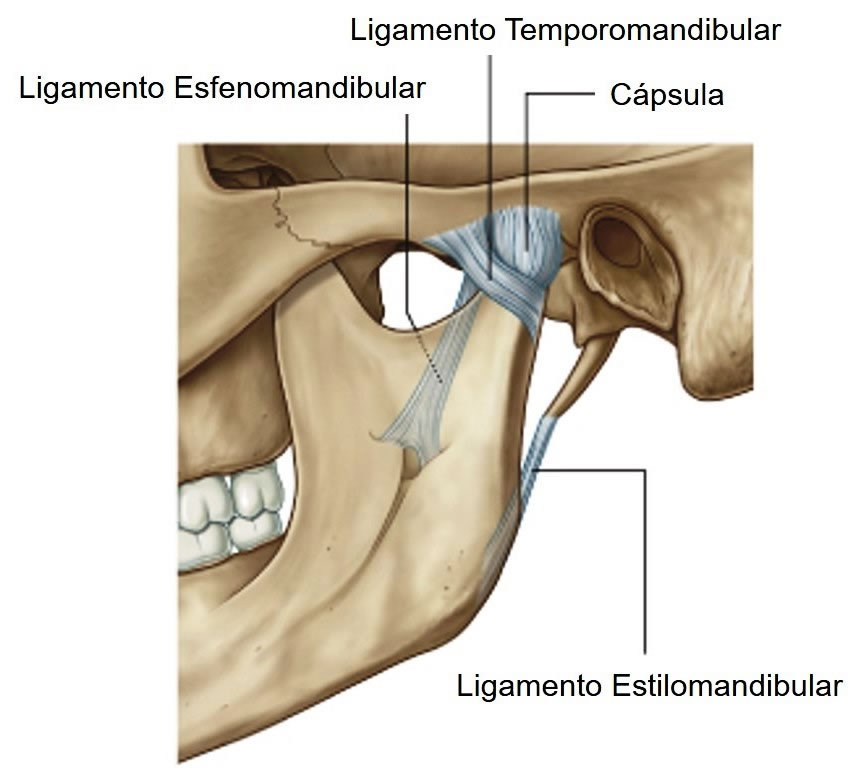 The task of treatment is to create the correct bite, in which the joint and muscles will function correctly.
The task of treatment is to create the correct bite, in which the joint and muscles will function correctly.
Comprehensive treatment may include:
Splint therapy. Splints are special individual medical caps that are made in our laboratory
Orthodontic treatment – moving teeth into the desired position
Orthopedic treatment – restoration of lost or destroyed teeth
Taping. Tapes are special elastic tapes that are glued to the skin and hold the joint in the desired position.
Botulinum therapy. Botulinum toxin injections help to relax constantly tense facial muscles
In some cases, if a conservative therapeutic approach to treatment is ineffective, surgical intervention is required. We give a referral to a hospital, and then we observe the patient and deal with his rehabilitation.
What is the danger of ignoring the problem?
The TMJ is one of the busiest joints in the body. When his work is disturbed, it becomes difficult for the patient to carry out simple and habitual actions: chew, swallow, yawn, speak. Therefore, if your joint hurts when you open your mouth, it becomes difficult to fully open and close your mouth, your jaw crunches when chewing, or any discomfort appears in the joint area, you should, without delay, sign up for a consultation with a gnathologist. The earlier the disease is detected, the more successful the treatment will be.
When his work is disturbed, it becomes difficult for the patient to carry out simple and habitual actions: chew, swallow, yawn, speak. Therefore, if your joint hurts when you open your mouth, it becomes difficult to fully open and close your mouth, your jaw crunches when chewing, or any discomfort appears in the joint area, you should, without delay, sign up for a consultation with a gnathologist. The earlier the disease is detected, the more successful the treatment will be.
TMJ diseases do not go away on their own, and if left unattended, they will progress and can lead to complete immobility of the lower jaw.
Temporomandibular joint: main problems and treatments
09/05/2013
In fact, nature or the Creator reproduced into the world an amazingly harmoniously balanced, interconnected in all its manifestations mechanism called Homo Sapiens. Any adult in the oral cavity after changing milk teeth to permanent ones has 28 teeth (in the presence of wisdom teeth 32). Such a “huge” number of teeth often leads to their neglectful use, sometimes leading to cruel, misuse and neglect.
Such a “huge” number of teeth often leads to their neglectful use, sometimes leading to cruel, misuse and neglect.
In the light of modern data on the relationship of various systems and organs, we can confidently say that the relationship between the digestive system, the bone composition of the body and the dental system is obvious. According to some authors, human posture has a direct impact on the development of the food skeleton, and the ratio of the jaws relative to each other.
Undoubtedly, the most important functional complex of the dental system is the temporomandibular joint. In its structure, it is a complex, anatomical formation, consisting of many individual units:
- Muscle fibers
- Joint capsule
- Condylar process
- Ligament apparatus
- Articular disc
- Articular tubercle
- Rear disc area
All of these components work as a single coherent mechanism. But as soon as one “screw” breaks, clinical manifestations will not take long.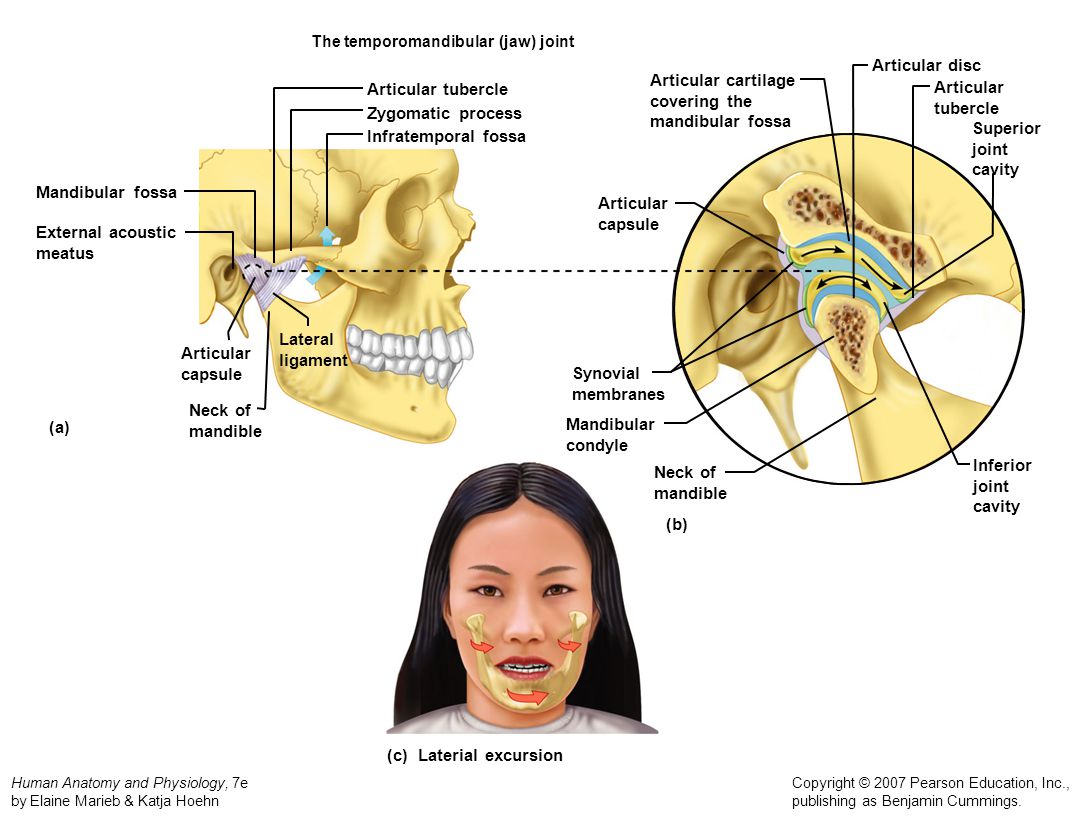 Objective examination reveals:
Objective examination reveals:
- Facial asymmetry – displacement of the central muscle of the face (most often to the side with total loss of teeth).
- Articular noises, sometimes very pronounced (patients note clicks, subluxations, but, as a rule, they do not attach sufficient importance to this, linking these manifestations with trauma in childhood, citing the fact that they have been living with this for 20 years or more.)
- Irradiation of pain manifestations outside the joint to the maxillofacial region.
- Mouth opening restriction. Pain syndrome, which can manifest itself with varying degrees of intensity, is an extreme form of dysfunction.
A special place in the functional aspect is occupied by the well-coordinated interaction of the articular complex, which includes the condylar process – an integral part of the lower jaw and the articular disc – a dividing cartilaginous base that separates the articular cavity and the condylar process. The purpose of the articular disc is to produce a lubricating fluid to reduce the friction of rubbing surfaces. Normally, the complex: the disc-condyle moves in the articular cavity and along the articular tubercle in unison, complementing each other. Support of the components relative to each other is possible only with the harmonious synchronous work of the muscular and ligamentous complexes.
The purpose of the articular disc is to produce a lubricating fluid to reduce the friction of rubbing surfaces. Normally, the complex: the disc-condyle moves in the articular cavity and along the articular tubercle in unison, complementing each other. Support of the components relative to each other is possible only with the harmonious synchronous work of the muscular and ligamentous complexes.
But in the process of life, due to certain reasons, there is a loss of teeth, a violation of harmony in the synchronous function of the muscles, which leads to a violation of the integrity of the functional interaction of the disc-condyle complex. As a result of these disorders, the condyle jumps off the disc, thereby forming persistent, distinct clicks (articular noises).
There are two methods to eliminate TMJ dysfunction: orthopedic and orthodontic.
As a rule, communication of related specialists is necessary to achieve the best possible result.
The factors that can provoke this pathological condition are basically acquired. These include:
These include:
- Loss of posterior teeth
Incorrectly performed restorations of chewing teeth in the clinic of therapeutic dentistry – which leads to a one- or two-sided decrease in the height of the bite, asymmetry of the face, followed by secondary deformations of the dentition and distraction of the condylar process into the postdiscal zone of bite – lead to hypermobility of the joint – overstretching of the ligamentous apparatus. Also, one cannot ignore periodontiopathy, which develops as a result of genetically determined or negative hygienic prerequisites. All this leads to such a serious illness.
For the diagnosis of TMJ dysfunction, the method of computed and magnetic resonance imaging is currently becoming increasingly important. Methods of morphological diagnostics without standing apart from functional diagnostics – axiography, electromonography, etc. they quite reasonably complement each other and, in combination, can reproduce an informative picture of the state of the TMJ for an accurate diagnosis.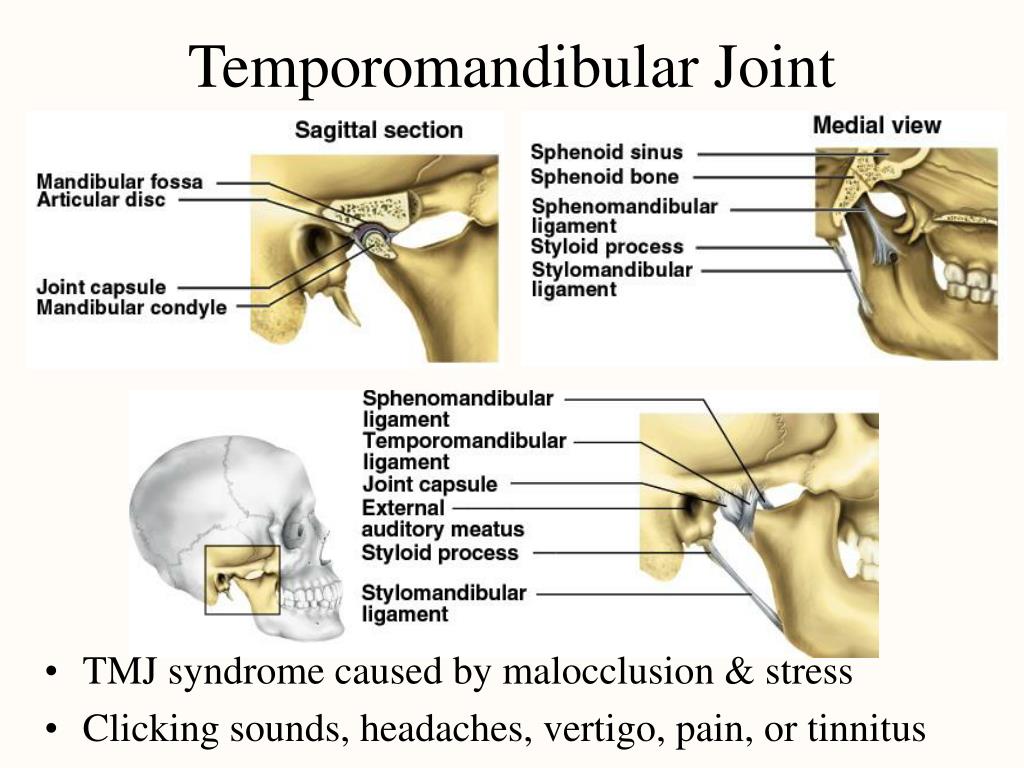




 Also know what the side effects are.
Also know what the side effects are.
